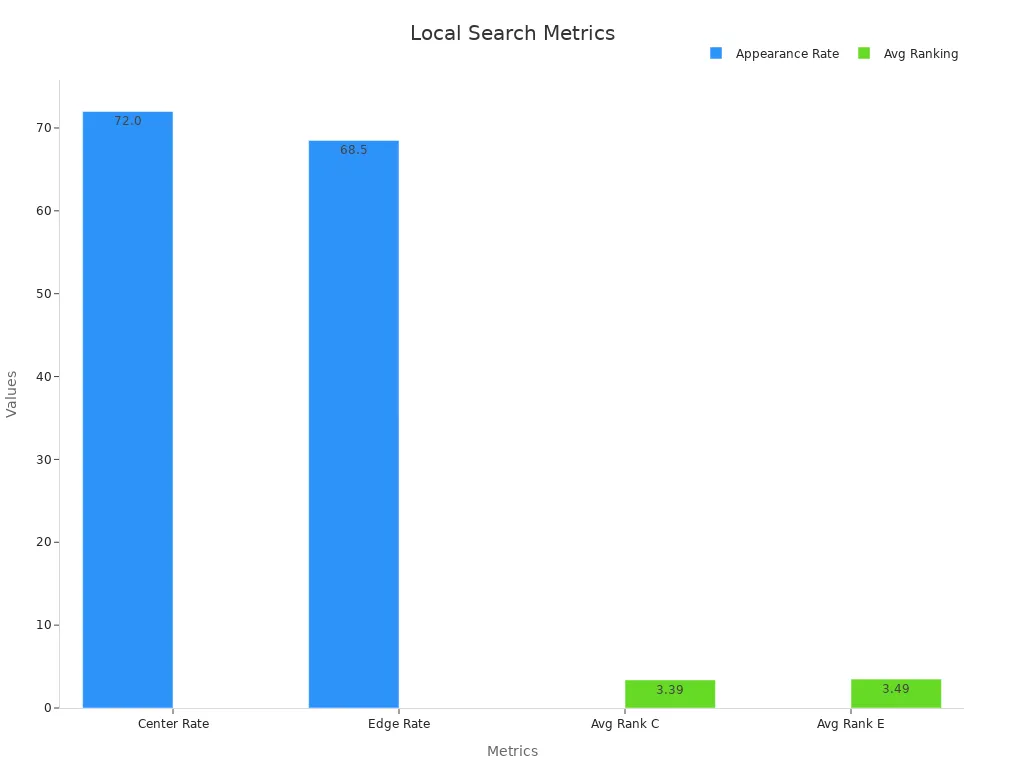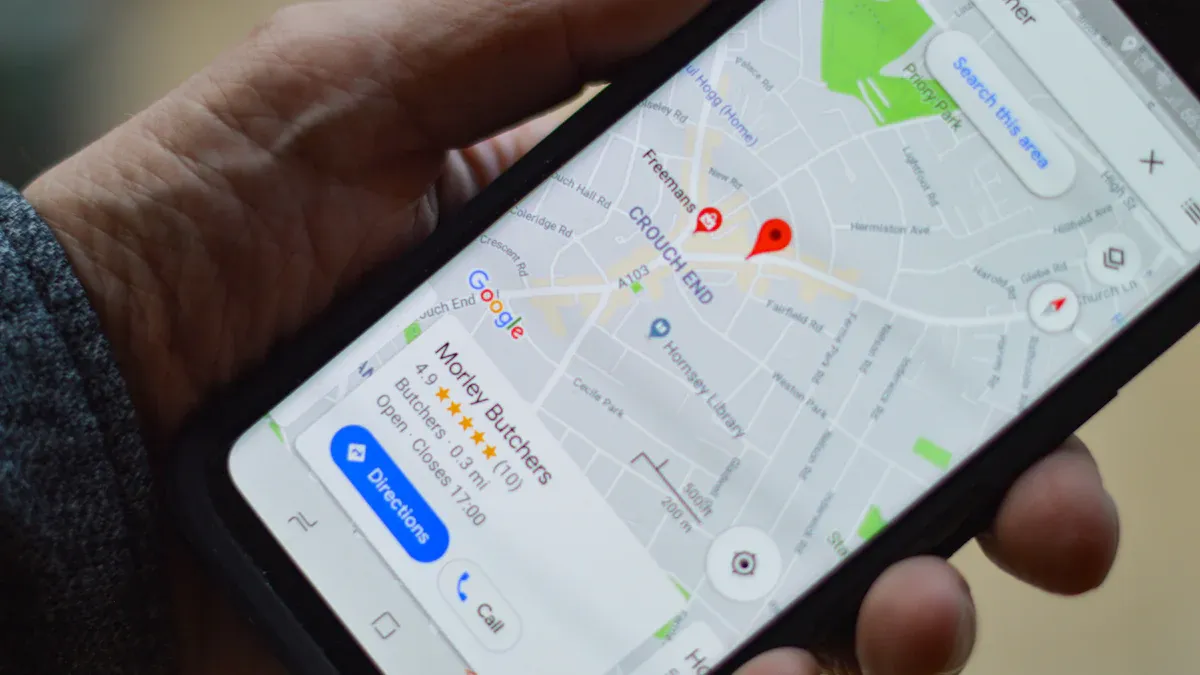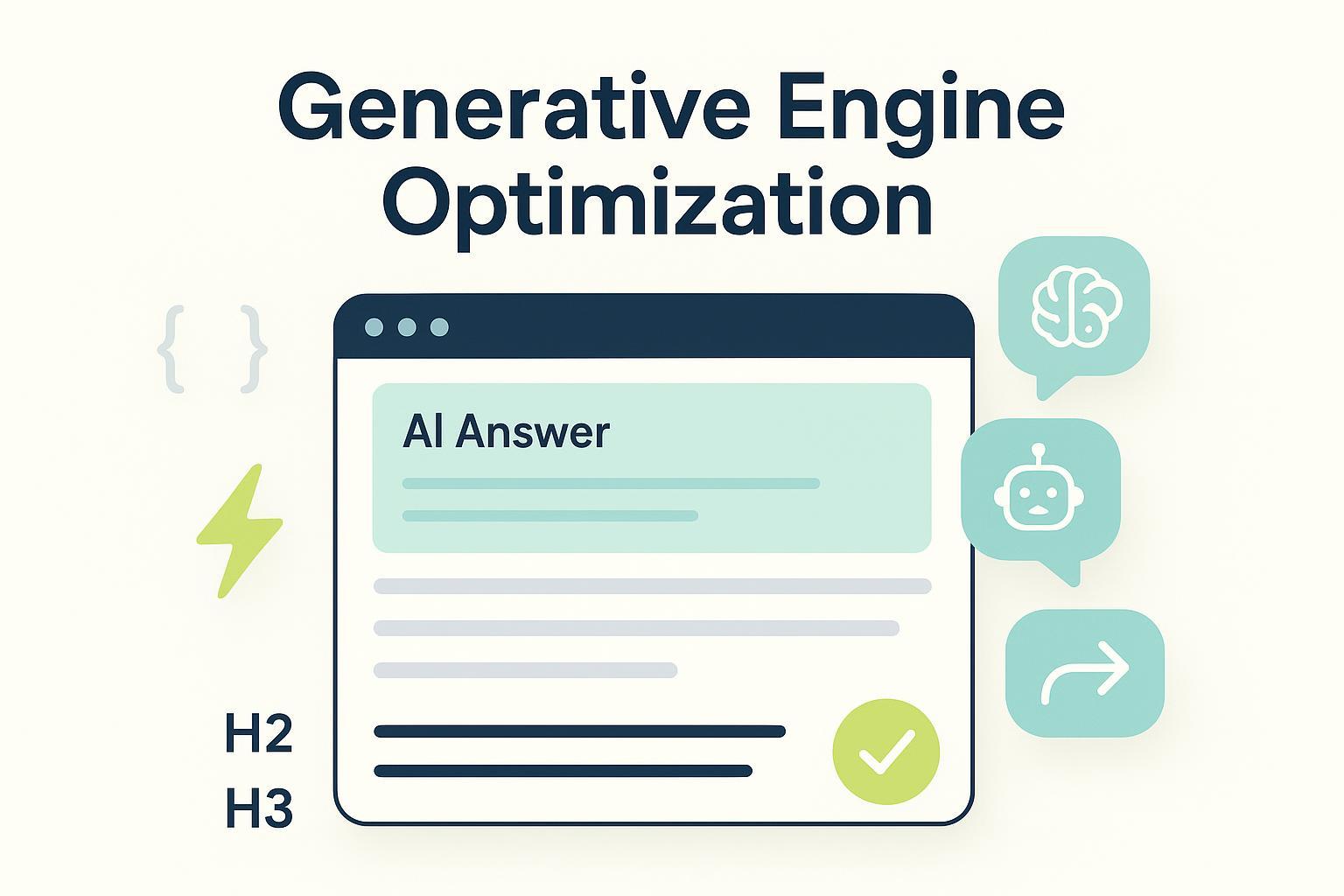Neighborhood Guides That Rank in Both Maps & AI Overviews
Learn how to create neighborhood guides that rank high in maps and AI overviews by optimizing for local SEO, user intent, and AI-friendly content.


When making neighborhood guides, ranking high in maps matters a lot. Why? Higher rankings bring more views and clicks. Studies show top map results get more visits than lower ones. It’s like giving your guide the best spot for customers. AI is changing how people search locally, focusing on being accurate and useful. If your guide doesn’t keep up, it might get ignored. Staying updated helps your guide stay important and easy to find.
Key Takeaways
Showing up high on maps helps people find you. Focus on being relevant, close by, and well-known to get more visitors.
AI is changing how people search locally. Write clear and interesting content to stand out in AI summaries and rank better.
Organize your guide carefully. Use titles, bullet points, and short sections so information is easy to read and find.
Keep your business details current. Correct info on your Google Business Profile builds trust and makes your guide more reliable.
Learn about AI changes. Update your content often to match new tools and local SEO trends.
The Basics of Ranking in Maps and AI Overviews
What It Means to Rank in Maps
Ranking in maps means being easy to find. When people search for places, they often pick top results. How can your guide get there? Three things matter most:
Relevance: Does your guide match what users want to find?
Proximity: Is the location close to the person searching?
Prominence: Is the area or business popular and trusted?
If your guide does well in these areas, it ranks higher. Think of it as being the first choice for visitors exploring the neighborhood.
How AI Overviews Are Changing Local Search
AI is changing how people search for local info. Instead of lists, AI gives summaries of the best options. Your guide needs to be clear, accurate, and interesting to stand out.
A study shows how AI affects rankings:
Metric | Value |
|---|---|
Distance-Based Ranking Correlation | |
Center Appearance Rate | 72.0% |
Edge Appearance Rate | 68.5% |
Average Ranking (Center) | 3.39 |
Average Ranking (Edge) | 3.49 |
Ranking Consistency (Stable) | High |
Ranking Consistency (Volatile) | Significant |

This data shows AI looks at both map centers and edges. Covering both areas in your guide helps it reach more people.
The Intersection of Maps and AI for Neighborhood Guides
Maps and AI now work together. Maps show locations, while AI explains them. For example, searching “best coffee shops” might show places based on reviews, distance, and popularity. Your guide should include all these details to rank better.
To succeed, make guides that are simple and helpful. Add landmarks, local spots, and unique features. This makes your guide a trusted tool for both map and AI searches.
Crafting Neighborhood Guides for Maximum Visibility
Understanding User Intent in Local Search
To make great neighborhood guides, know what people want. Local searches are about finding places or services nearby. For example, people often search for "coffee shops near me" or "best parks in [city]." This is called local intent.
“The best way to understand search intent is by learning from real users. See how they think and search. Search engines aim to match what users want.”
Here’s what you should know about local searches:
People use phrases like "near me" or "in [location]" often.
They want quick, helpful results that fit their location.
Match your content to these habits to make it useful. If writing about a neighborhood, include popular spots, hidden gems, and practical tips like parking info. This helps your guide meet user needs and rank better.
Structuring Content for AI and Map Algorithms
Search engines and AI prefer clear, organized content. Messy guides don’t rank well. Divide your guide into sections with headings, bullet points, and short paragraphs.
For example:
Introduction: Share a quick overview of the neighborhood.
Key Attractions: List parks, landmarks, or cultural spots.
Local Favorites: Mention cafes, restaurants, or shops locals love.
Practical Info: Add tips like transportation or safety advice.
AI likes guides with detailed info. Include names, addresses, and hours for places. This makes your guide stand out in maps and AI summaries. The goal is to be the best resource for exploring the area.
Incorporating Local SEO Best Practices
Local SEO helps your guide get noticed. Focus on these areas:
Local Organic Search Rankings: Use keywords naturally to boost visibility.
Google Business Profile Insights: Keep business info correct and updated.
Website Traffic and User Behavior: Check how people use your guide to improve it.
Conversion Metrics: Track bookings or leads from your guide.
Online Reviews and Ratings: Get reviews to build trust and credibility.
For example, if you mention a bakery, add its name, address, and website link. This helps users and shows search engines your guide is reliable. Over time, these details can improve your guide’s ranking.
By using user insights, clear structure, and local SEO tips, you can make neighborhood guides that rank high and help readers.
Optimizing for Map-Based Searches

Keeping Map Listings and Business Info Correct
If your map info is wrong, you’ll lose visitors. People use maps to find places and services. If details are outdated, they’ll pick another option. That’s why keeping everything updated is so important.
Start by completing your Google Business Profile. Add the right name, address, phone number, and website. Include business hours and photos too. These small updates make your guide more helpful and trusted.
Pro Tip: Check your listings on all platforms, not just Google. Being consistent builds trust and helps your guide rank higher in map searches.
Ask local businesses in your guide to claim their profiles. This keeps their info correct and makes your guide more reliable. When users trust your guide, they’ll come back and share it with others.
Using Schema Markup to Show Important Info
Schema markup may sound tricky, but it’s very useful. It’s a type of code that helps search engines understand your content. For neighborhood guides, it can make your guide stand out.
Here’s why schema markup is helpful:
It ensures search engines show business locations correctly.
It creates rich snippets with details like ratings and hours.
For example, the LocalBusiness schema can highlight spots like cafes or parks. This makes your guide more noticeable in search results, gaining user trust and clicks.
Did You Know? Guides with schema markup often show extra details in search results, even if they rank lower. This extra visibility is great for guides about specific areas.
Adding schema markup might need some tech skills, but it’s worth it. If you’re unsure, tools like Google’s Structured Data Markup Helper can assist you.
Getting Ready for Voice Search and Mobile Use
Voice search is growing fast in local searches. Many voice searches are about nearby places or services. If your guide isn’t ready for voice search, you’re missing out.
To prepare, use natural language. People talk differently than they type. Instead of typing “pizza shop LA,” they might ask, “Where’s the best pizza near me?” Add conversational phrases and questions to match these searches.
Mobile optimization is just as important. Most voice searches happen on phones, so your guide must work well on mobile. Make sure it loads quickly, is easy to navigate, and looks good on small screens.
Quick Tip: Test your guide on different devices to check its performance. A smooth mobile experience can boost your map search rankings.
By combining voice search and mobile readiness, you make your guide easier to find and use. This improves visibility and keeps users happy.
Enhancing Trust and Authority for Neighborhood Guides
Using Reviews and Ratings to Build Credibility
Reviews and ratings help people trust your neighborhood guide. Honest feedback from locals and visitors makes guides reliable. If your guide lists businesses, ask them to gather reviews on sites like Google or Yelp. Good ratings attract more users and boost trust.
You can add quotes or testimonials from happy customers. For example, if a café has great reviews about its cozy vibe, mention it. This makes your guide feel personal and relatable.
Pro Tip: Replying to reviews—whether good or bad—shows businesses care. This builds trust and encourages people to engage.
Getting Backlinks from Local Sources
Backlinks are links from other websites to your guide. They show search engines your guide is trustworthy. Local links from businesses, blogs, or news sites are especially helpful.
Here’s what studies say about backlinks:
Key Findings | Description |
|---|---|
Importance of Backlinks | |
City in Anchor Text | Adding the city name in links helps local searches. |
To get backlinks, work with local businesses. Offer to feature them in your guide if they link to you. You can also write for community blogs or sponsor events. These steps make your guide stronger and easier to find.
Using Social Media to Build Authority
Social media helps promote your neighborhood guide. Platforms like Instagram and Facebook let you share photos, videos, and stories. These show off the area’s best features.
Using data can improve your social media posts. Look at how people interact with your content to learn what works. For example:
Metric | Description |
|---|---|
Engagement Rates | |
Follower Growth | Watch follower numbers to measure how well your strategy works. |
Website Traffic | See how many visitors come from social media to learn their interests. |
Quick Tip: Use live analytics to update posts based on trends. This keeps your content interesting and fresh.
Social media isn’t just for posting—it’s for connecting. Reply to comments, ask questions, and make polls to involve users. When people feel included, they trust and share your guide more.
Adapting to AI-Driven Search Trends
How AI Models Evaluate Content for Local Search
AI uses smart ways to check how good your content is. These checks make sure your neighborhood guide is helpful and correct. Here’s a simple look at how AI checks content:
Metric | Description |
|---|---|
Matches your content with other data to see if it fits the right meaning. | |
Ground Truth | Acts like a rulebook to make sure your guide is true and reliable. |
Hallucination Rate | Counts how often wrong details show up, which can hurt trust. |
Perplexity | Checks how easy your content is to follow, helping AI see its quality. |
Relevancy Metrics | Sees if your guide answers questions clearly and simply. |
AI likes content that’s clear, true, and easy to read. Focus on these to help your guide rank better in searches.
Tip: Don’t use confusing words. AI likes simple and clear content.
Creating AI-Friendly Content for Neighborhood Guides
To make your guide good for AI, create top-notch, useful content. Good content gets more views than boring posts. Here’s how to make your guide AI-friendly:
Answer user questions fully.
Group related topics to show you know your stuff.
Use related words and ideas.
Make sure your guide is fast and easy to use.
Being relevant is important. Most marketers say it’s key for search success. Match your content with what users want by giving clear details and tips. For example, if users look for “best parks in [city],” add info, pictures, and directions.
Pro Tip: Try different styles, like lists or pictures, to see what your readers like best.
Staying Updated on AI Innovations in Local SEO
AI changes fast, so keep learning. New tools like sentiment checks and local tags are changing local SEO. Good reviews can help your guide show up more by affecting AI’s view.
Here’s how to stay ahead:
Watch AI news and trends in local SEO.
Use tags to help search engines sort your guide.
Make content that fits the local area to keep readers interested.
By staying updated, your neighborhood guide will stay useful and popular.
Quick Tip: Check how your guide is doing, like how long people stay on it, to find ways to make it better.
Making your neighborhood guides work for both maps and AI overviews is very important. A well-ranked guide helps locals and visitors find what they need easily.
Here’s how to improve your guide:
Use local SEO to make it easier to find.
Add reviews, correct details, and fun content to build trust.
Keep up with new AI-driven trends to stay ahead.
Pro Tip: Check your guides often. Fix old info, add missing details, and make them simple to use.
Start using these tips today, and your guides will become the best tool for exploring neighborhoods!
FAQ
What helps a neighborhood guide rank higher in maps?
Focus on being relevant, close, and popular. Include correct details like addresses, hours, and reviews. Add local landmarks and favorite spots to make your guide better.
Tip: Keep your Google Business Profile updated for better visibility.
How can I make my guide better for AI searches?
Write clear, detailed content that answers questions. Use everyday language and include local keywords. Add schema markup to show important information.
Pro Tip: Test your guide for voice search by asking, “What’s the best park near me?”
Why is mobile optimization important for neighborhood guides?
Most users search on their phones. A mobile-friendly guide loads fast, looks good on small screens, and is easy to use.
Quick Tip: Test your guide on different devices to ensure a smooth experience.
How do reviews and ratings affect my guide’s ranking?
Good reviews build trust and help rankings. They show users and search engines that your guide is reliable. Encourage businesses in your guide to get reviews on sites like Google or Yelp.
What’s the best way to stay updated on AI trends in local SEO?
Follow industry blogs, join webinars, and try new tools. Regularly check your guide to make sure it fits with the latest AI search practices.
Note: Staying informed helps you adapt quickly and keep your guide relevant.
See Also
Strategies for Achieving High Rankings in AI Summaries
Enhancing Real Estate Listings for AI-Driven Buyer Experiences
Creating AI-Optimized Review Snippets for Improved GEO in 2025
Effective Techniques to Achieve High Rankings in Perplexity AI





